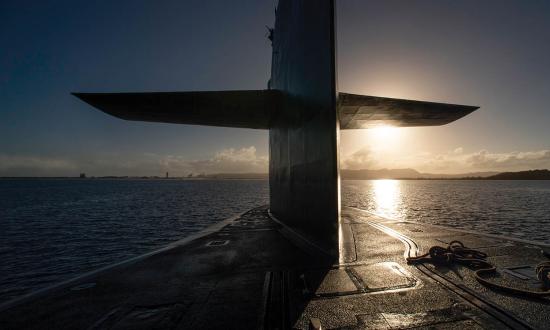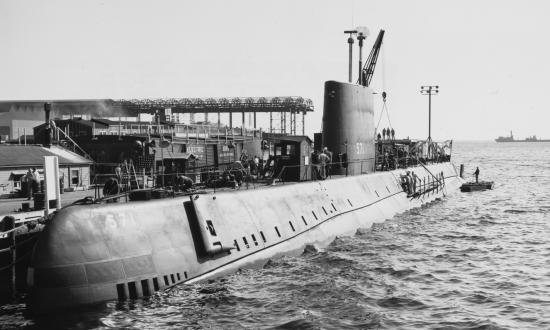Direct support element (DSE) teams are temporarily embarked information specialists who support national and fleet objectives by providing situational awareness and indications and warning for deployed submarines. There is little public documentation on DSE, which can make it difficult to understand its history and current capabilities. As the Navy continues to propel a “Get Real, Get Better” mindset, it is paramount to understand the rich history and present state of DSE, while acknowledging current problems and potential solutions that may affect them.
Recent developments have been made to bolster DSE teams and information warfare capabilities for the U.S. submarine force, but issues remain. The most common challenge is the “outsider tax.” DSE teams are not part of the ship’s company, and must efficiently integrate with each crew, quickly demonstrating value and competence to warrant the additional rack they occupy. They must adhere to unstable schedules and operational tempos that far exceed the average sailor; all while receiving frequently updated fleet tasking that places them in the most challenging environments.
As a result, most enlisted DSE personnel require operating tempo (OpTempo) waivers to meet the heavy demand. Similarly, most of the officers leading these teams are first-tour junior officers expected to operate at an at-sea department head level with subsequent tours focused on other information warfare missions. This leaves DSE officer roles predominantly with O-2s/O-3s and fails to use the experience of more senior information warfare officers. The Navy must act to better support these teams.
The Link
With a history as deep as its operations, submarine warfare accomplished some of the most critical and sensitive objectives of World War II. In similar prominence, highly skilled cryptanalysts and Japanese linguists provided the asymmetric advantage in the nation’s most critical moments during and prior to the Battle of Midway, such as breaking the Japanese naval code JN-25. Decades have passed, but submarine warfare and information warfare/cryptology remain bedrocks of maritime dominance and have a defining link between each other: DSE teams. Today’s DSE teams face challenges with unit integration, high OpTempo, and poor officer progression. The solutions to these issues are as diverse as the problems but supporting them will better position the DSE construct in the next decade.
History and Current Capabilities
One of the first instances of DSE support to submarines began in the late 1940s by Cryptologic Technician Collection Harris Monroe “Red” Austin. Red served on board the USS Cochino (SS-345) and trained in Morse communications and electronic intelligence/electronic support measure operations. The Cochino was tasked to navigate in a highly dynamic and contentious operating area, and Red was given specific orders to provide best recommendations for tactical positioning and the use of special equipment. His perilous efforts and wide success resulted in a commendation from the Chief of Naval Operations (CNO) and a framework for direct support to submarines.
Today, the need for DSE is more pressing than ever. DSE teams have advanced far beyond the capacity of the Cochino and encompass a diverse spectrum of information warfare specializations. Each team consists of more than ten personnel who provide enhanced capabilities not inherent to the submarine force. Members perform sophisticated installations and repairs; identify, locate, and report worldwide threats; and provide tactical and strategic intelligence to commanders by using national capabilities. For decades, DSE teams have supported the highest levels of critical intelligence requirements and remain the experts in information warfare support to submarines.
Recommendations
The former CNO has chartered every sailor to adapt to the practice of “Get Real, Get Better,” described as “the courage to self-assess, to build teams that embrace honest, hard, transparent looks at our performance.” In terms of information warfare personnel and capabilities on submarines, the Navy lacks the appropriate training, funding, regional expertise, and integrated approach to overcome internal challenges. That said, the Navy can take action to support DSE teams and information warfare capabilities.
First, the Navy should ensure appropriate senior leaders exists to improve and manage information warfare undersea capabilities. The information warfare type commander, Naval Information Forces, provides influence and appropriate background to manage these issues, but the command has a litany of other responsibilities and interests. Ensuring there is ownership by more information warfare and submarine flag officers across the multiple agencies that support DSE teams and other information warfare subsurface capabilities is paramount for future success. This would help ease the challenges of DSE integration as more senior leaders align toward initiatives of greater coordination.
Second, the Navy should redefine the use of DSE teams to address the high OpTempo. Instead of having a DSE team for every deployed submarine commander, the teams should be reserved to meet discrete objectives reviewed by senior submarine and information warfare leaders.
Third, the Navy could improve retention through bonuses and other monetary measures, while increasing the number of billets assigned in the fleet for officers and enlisted DSE. Fourth, the Navy should increase the number of milestone positions at the O-4 and O-5 level and establish O-5 commands dedicated solely to the support and function of DSE teams. Additional leadership opportunities would ensure the correct level of support for DSE, while also providing career progression for officers who specialize in this tradecraft.
Finally, there needs to be greater investments for training and equipment. In terms of training, there should be a more integrated approach to preparing teams, including using commands such as the Naval Information Warfare Development Command and others to provide best practices, consolidated tactics, techniques, and procedures, and a cadre of expert warfare tactic instructors that can provide a sharper edge in the undersea fight. In terms of equipment, the Navy must better coordinate with industry partners—both commercial and government—to provide the highest-level intelligence capabilities to help detect and deter peer competitors. The current slow and detached procurement process places needed equipment years behind what is necessary to compete.
The Next Decade
Information warfare and submarine warfare provide two key elements to win future battles. The continued coordination of the two professions will be essential. Although measures are being taken to bolster undersea information warfare capabilities and DSE teams, more must be done to invest in new technologies and systems, while also promoting the warfare capabilities of sailors and officers. Decision-makers should continue to take on a “Get Real, Get Better” approach as it pertains to the future of information warfare on submarines; the cadre of individuals who support these operations continue to represent the finest sailors in the information warfare community and they deserve the very best.






